|
General "Stonewall" Jackson and the 1862 Valley Campaign
Jackson's Valley Campaign [March-June 1862]: A History
| Stonewall Jackson's 1862 Valley Campaign Map |
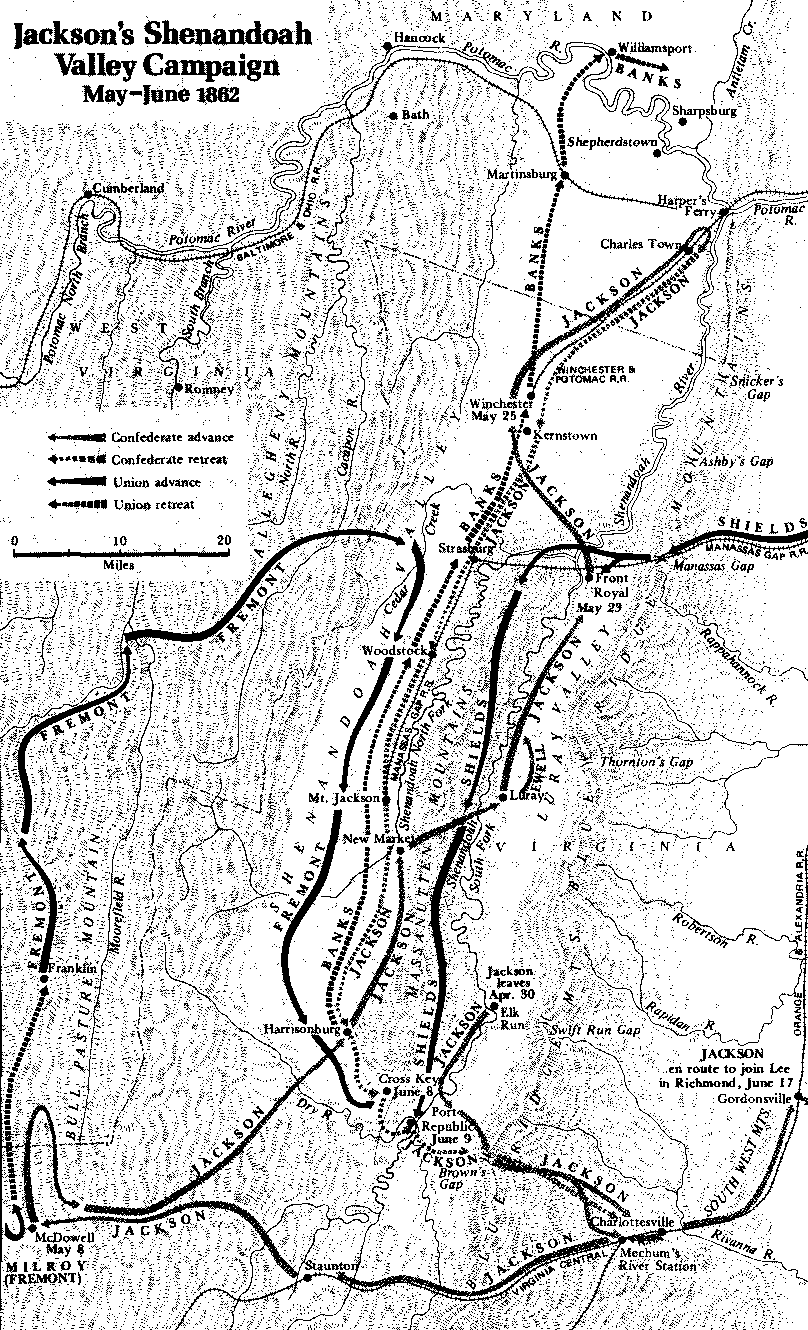
|
| The Stonewall Jackson Valley Campaign Map |
"Stonewall" Jackson's Valley Campaign in 1862
Overview: Jackson's Valley Campaign was Confederate Maj. Gen. Thomas J. "Stonewall" Jackson's famous spring 1862 campaign through the Shenandoah Valley in Virginia during the American Civil War. Employing audacity and rapid, unpredictable movements
on interior lines, Jackson's 17,000 men marched 646 miles (1,040 km) in 48 days and won several minor battles as they successfully
engaged three Union armies (52,000 men), preventing them from reinforcing the Union
offensive against Richmond. The Jackson Valley Campaign estimated total losses: Union Casualties 5,735; Confederate Casualties
2,441.
Since only one principal battle
(First Kernstown in March 1862) occurred prior to May 1862, many historians refer to the campaign as "Jackson's
Valley Campaign of May-June 1862."
Objective: To keep Union forces from reinforcing
McClellan on the Peninsula, Jackson and the fast-moving infantrymen he called his "foot cavalry" ranged up and down the Shenandoah
Valley in northern Virginia, despite the best efforts of three Federal commanders - John Charles Frémont, Nathaniel Banks
and Irvin McDowell - to stop him. Banks lost so many supplies to Jackson's lightning raiders that Confederates took to calling
him "Commissary Banks."
| Stonewall Jackson Shenandoah Valley History & Map |
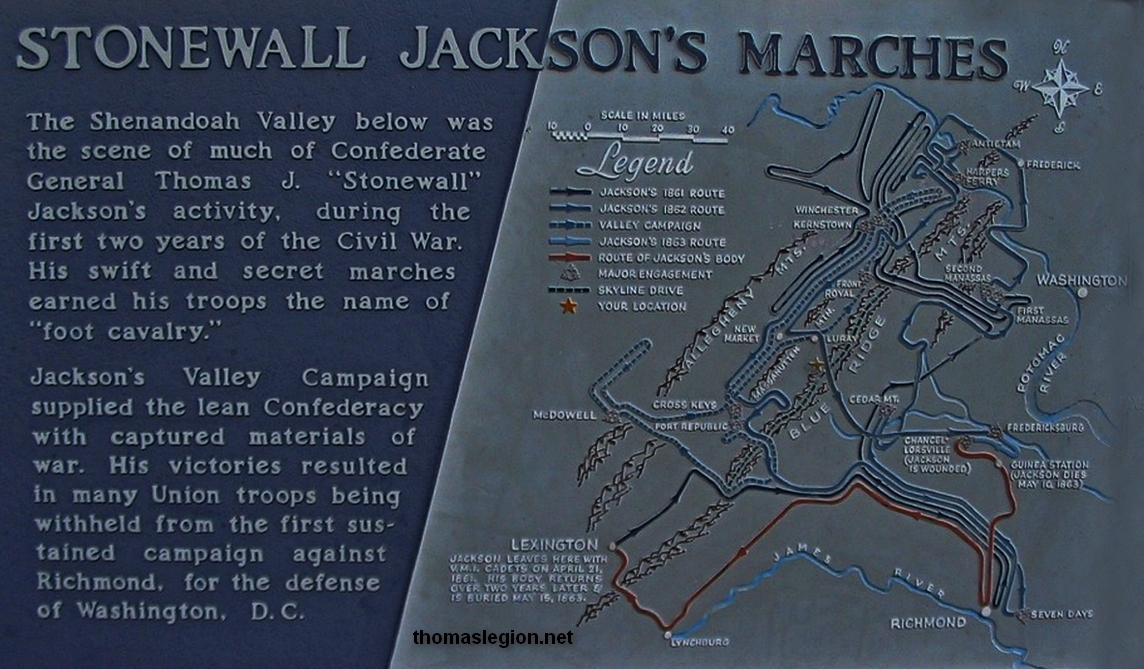
|
| Stonewall Jackson's Valley Campaign |
| Stonewall Jackson Monument |

|
| (Richmond, Virginia) |
Battles:
The principal battles fought during Jackson’s 1862 Valley Campaign were: Kernstown I, McDowell (aka Sitlington’s Hill), Princeton
Courthouse (aka Princeton Court House, [now] West Virginia),
Front Royal (aka Guard Hill, and Cedarville), Winchester I (aka Bowers Hill), Cross Keys, and Port Republic.
Campaign:
“Stonewall” Jackson suffered a defeat (his sole defeat of the war) at the First Battle of Kernstown (March 23,
1862) against Col. Nathan Kimball (part of Union Maj. Gen. Nathaniel P. Banks's army), but it proved
to be a strategic Confederate victory because President Abraham Lincoln reinforced his Valley forces with troops that had
originally been designated for the Peninsula Campaign against Richmond.
On
May 8, after more than a month of skirmishing with Banks, Jackson
moved deceptively to the west of the Valley and defeated elements of Maj. Gen. John C. Frémont's army in the Battle of McDowell,
preventing a potential combination of the two Union armies against him. Jackson
then proceeded down the Valley, again, to confront Banks. Concealing his movement in the Luray
Valley, Jackson joined
forces with Maj. Gen. Richard S. Ewell and captured the Federal garrison at Front Royal on May 23, causing Banks to retreat
to the north. On May 25, in the First Battle of Winchester, Jackson defeated Banks and pursued
him until the Union Army crossed the Potomac River into Maryland.
(Right) Statue of General
"Stonewall" Jackson near the State Capitol in Richmond, Virginia.
Bringing in Union reinforcements
from eastern Virginia, Brig. Gen. James Shields recaptured
Front Royal and planned to link up with Frémont in Strasburg. Jackson
was now threatened by three small Union armies. Withdrawing up the Valley from Winchester,
Jackson was pursued by Frémont and
Shields.
On
June 8, Ewell defeated Frémont in the minor Battle of Cross Keys and on the following day, crossed the North River to join
forces with Jackson to defeat Shields in the Battle of Port
Republic. Jackson immediately followed up his successful campaign by forced marches to join
Gen. Robert E. Lee for the Seven Days Battles outside Richmond.
His audacious campaign elevated him to the position of the most famous general in the Confederacy (until this reputation was
later supplanted by Lee) and has been studied ever since by military organizations around the world.
| Shenandoah Valley Civil War Battlefield Map |
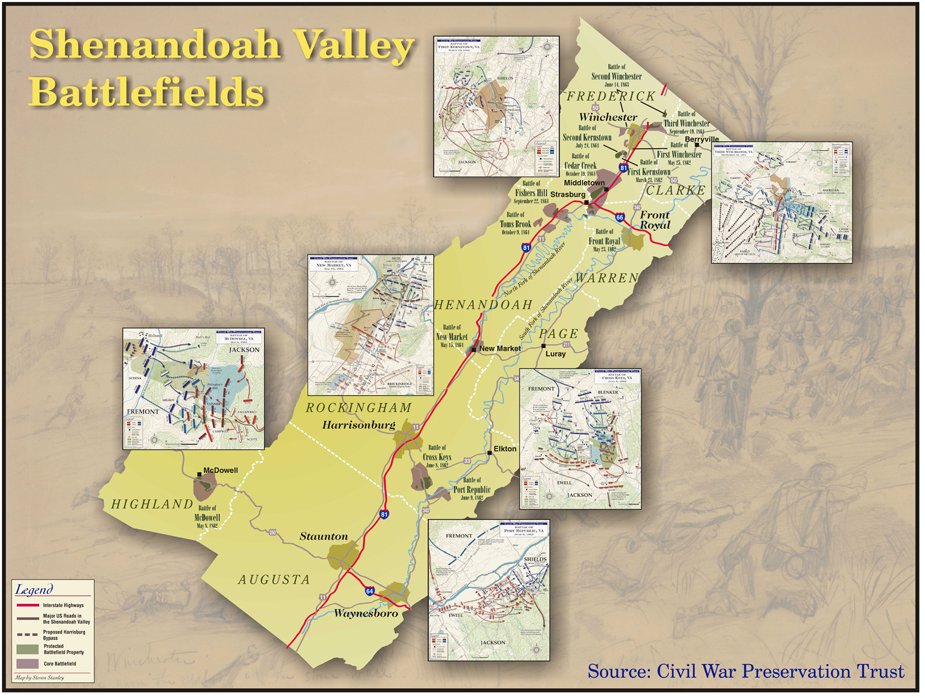
|
| Civil War in the Shenandoah Valley Map |
General "Stonewall" Jackson
and the Valley Campaign: A Civil War Study
| General Stonewall Jackson Shenandoah Valley |
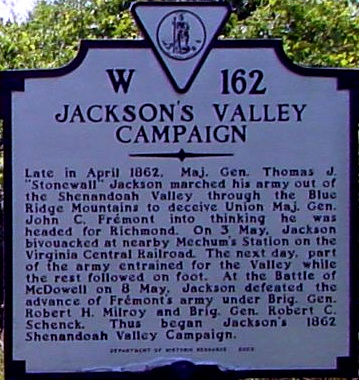
|
| (Historical Marker) |
Narrative:
After the bombardment of Fort
Sumter, South Carolina, and President Lincoln's call for 75,000 volunteers, Virginia seceded on April 17, 1861. At once, Virginia
State militia moved to secure the railroad assets, musket factories, and the Federal
armory and arsenal at Harpers Ferry. Although Union forces attempted to burn the facilities,
most of the rifle-musket manufacturing equipment was salvaged and shipped south to bolster the Confederate ordnance effort.
Former VMI professor Thomas J. Jackson assumed command of a newly formed brigade at Harpers Ferry
in the spring and moved to consolidate Confederate strength in the area. In July 1861, Confederate reinforcements traveled
from the Shenandoah Valley to Manassas Junction on the Manassas Gap Railroad to reach the fighting at Bull
Run, marking the first time in modern warfare that troops were moved by train to a battlefield. On the battlefield
of Manassas, Jackson earned
the sobriquet "Stonewall.''
| Stonewall Jackson House |
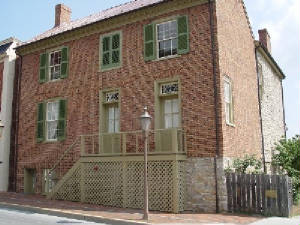
|
Although the remainder of
the year saw sporadic skirmishing and an engagement at Falling Waters along the Potomac River,
most of the fighting during the summer and fall of 1861 occurred farther to the west. During this time, Confederate forces
gradually lost political and military control of the counties that would later be incorporated into the new state of West Virginia. In winter 1861-1862, Jackson
conducted a campaign against Union forces at Romney, West
Virginia.
(Left) Prior to the Civil War, Thomas J. Jackson was a professor at the Virginia
Military Institute in Lexington, and, during that time, he
lived in this house on Washington Street.
March-June 1862:
Maj. Gen. Thomas J. Jackson's Valley Campaign of 1862 is one of the most studied campaigns of military history. This campaign
demonstrates how a numerically inferior force can defeat larger forces by fast movement, surprise attack, and intelligent
use of the terrain. In March 1862, as a Federal force under Maj. Gen. Nathaniel Banks began to advance cautiously up the Valley,
General Jackson retreated to Mount Jackson
where he could defend the Valley Turnpike. His task was two-fold--to prevent deep penetration into the Valley and to tie down
as many opposing forces as possible. When he learned that Banks was ready to detach part of his force to assist the Army of
the Potomac then being concentrated on the Peninsula to threaten Richmond, Jackson marched down the Turnpike and fought a battle at Kernstown on March 23.
Although defeated, Jackson's aggressive move convinced Washington that Confederate forces
in the Valley posed a real threat to Washington, and Maj. Gen. George B. McClellan, with
his army preparing to move on Richmond, was denied reinforcements
at a critical moment in the Peninsular Campaign.
| Stonewall Jackson Civil War Shenandoah Valley |
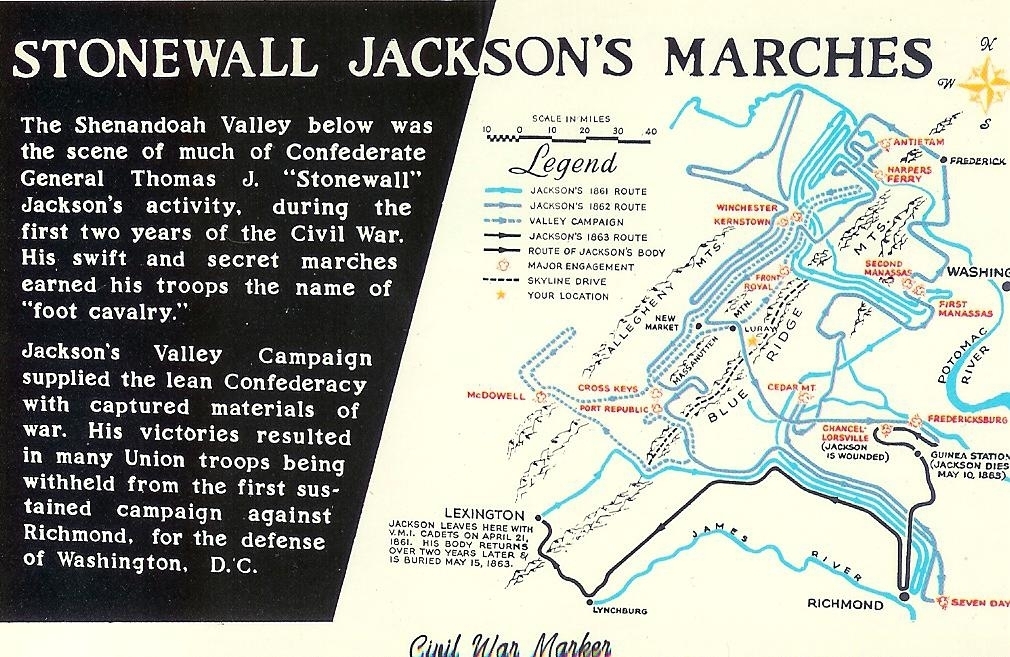
|
| Jackson's Valley Campaign Map |
| General Stonewall Jackson |
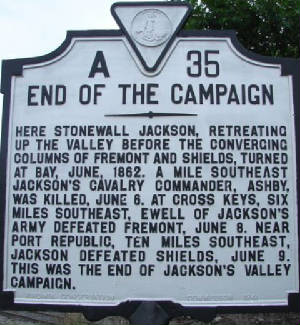
|
| (Historical Marker) |
In late April, Jackson left part of his
enlarged command under Maj. Gen. Richard S. Ewell to confront Banks and marched with about 9,000 men through Staunton
to meet a second Union army under Maj. Gen. John C. Fremont, whose vanguard approached on the Parkersburg Road from western Virginia.
Banks was convinced that Jackson was leaving the Valley to join the Confederate army at Richmond.
But on May 8, Jackson turned up to defeat two brigades of Fremont's
force, under Brig. Gens. Robert Milroy and Robert Schenck, at McDowell. He then marched swiftly back to unite with Ewell against
Banks.
(Right) Last Campaign. Many historical markers remind the nation
of what occurred during the campaign, but the location of this marker once reminded the many who had served and fought under
"Stonewall" Jackson, that they had survived it.
On May 23, Jackson
overran a detached Union force at Front Royal and advanced toward Winchester,
threatening to cut off the Union army that was concentrated around Strasburg. After a running battle on the 24th along the
Valley Turnpike from Middletown to Newtown (Stephens
City), Banks made a stand on the heights south of Winchester.
On May 25, Jackson
attacked and overwhelmed the Union defenders, who broke and fled in a panic to the Potomac River.
Banks was reinforced and again started up the Valley Turnpike, intending to link up with Brig. Gen. James Shields's Union
division near Strasburg. Shields's division spearheaded the march of Irwin McDowell's corps recalled from Fredericksburg,
while Fremont's army converged on Strasburg from the west.
Jackson withdrew, narrowly avoiding being cut off from his
line of retreat by these converging columns.
| Lieutenant General "Stonewall" Jackson |
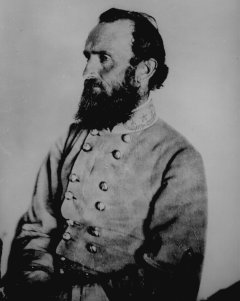
|
| (National Archives) |
The Union armies now began
a two-prong offensive against Jackson. Fremont's troops
advanced up the Valley Turnpike while Shields's column marched up the Luray Road
along the South Fork. At this point nearly 25,000 men were being brought to bear on Jackson's
17,000. Jackson's cavalry commander, Brig. Gen. Turner Ashby was killed while fighting a rear
guard action near Harrisonburg on June 6.
Jackson
concentrated his forces near the bridge at Port Republic, situating himself between the two Union columns that were separated by the
mountain and the rain-swollen Shenandoah South Fork. On June 8, Fremont
attacked Ewell's division at Cross Keys but was driven back. The next morning (June 9), Jackson
with his remaining force attacked Shields east and north of Port Republic,
while Ewell withdrew from Fremont's front burning the bridge
behind him. Ewell joined with Jackson to defeat Shields. Both
Union forces retreated, freeing Jackson's army to reinforce the Confederate army at Richmond.
In five weeks, Jackson's army had marched more than 650 miles and inflicted more than 7,000 casualties,
at a cost of only 2,500. More importantly, Jackson's campaign
had tied up Union forces three times his strength. Jackson's victories infused new hope and
enthusiasm for the Confederate cause, and materially contributed to the defeat of McClellan's campaign against Richmond.
| Stonewall Jackson Valley Campaign Map |

|
| Stonewall Jackson Valley Campaign Map |
The Valley Campaign: Aftermath and Analysis
| General Richard Ewell |

|
| (LOC) |
After Jackson's victories at Cross Keys and
Port Republic,
the Union forces withdrew. Frémont marched back to Harrisonburg, where he was frustrated to
find orders from Lincoln he had not received in time, telling him not to advance beyond that
town against Jackson. As the weather became clear, Jackson's cavalry under Col. Thomas T. Munford harassed Frémont's withdrawal, which reached Mount Jackson on June 11, and then unencumbered to Middletown on June 14 where he joined with Banks and Brig. Gen. Franz
Sigel. Shields, who complained bitterly about the exhaustion of his division, marched slowly to Front Royal and on June 21
marched across the Blue Ridge to join Maj. Gen. Irvin McDowell.
| General John Frémont |
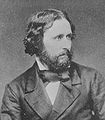
|
| (LOC) |
Jackson sent messages to Richmond requesting that his force be augmented to 40,000 men so that he could assume the offensive down
the Valley and across the Potomac, but Robert E. Lee, now commanding the Army of Northern Virginia, had other plans—to
counterattack McClellan's Army of the Potomac and drive it away from Richmond.
He needed all of the combat power he could muster and he wanted Jackson to attack the relatively
unprotected right flank of McClellan's army, north of the Chickahominy
River. Shortly after midnight on June 18, Jackson's
men began to march toward the Virginia Peninsula.
They fought with Lee in the Seven Days Battles, from June 25 to July 1. Jackson delivered an
uncharacteristically lethargic performance in many of those battles, perhaps because of the physical strains of the Valley
Campaign and the exhausting march to Richmond.
| General Robert Schenck |

|
| (LOC) |
With the success of his
Valley Campaign, "Stonewall" Jackson became the most celebrated soldier in the Confederacy (until his reputation was eventually
eclipsed by Lee's), and his victories lifted the morale of the public. In a classic military campaign of surprise and maneuver,
he pressed his army to travel 646 miles (1,040 km) in 48 days of marching and won five significant victories with a force
of about 17,000 against a combined force of over 50,000. Jackson had accomplished his difficult mission, causing Washington
to withhold over 40,000 troops from McClellan's offensive. Military historians Herman Hattaway and Archer Jones summarized
a successful campaign:
| General James Shields |

|
| (LOC) |
“Always outnumbered
seven to three, every time Jackson engaged he fought with the odds of about four to three in his favor—because, moving
rapidly on interior lines, he hit fractions of his enemy with the bulk of his own command. ... Jackson
enjoyed the great advantage that the northerners remained widely scattered on a perimeter within which his troops could maneuver
to concentrate against first one and then another of the Union forces. Lincoln
managed very well, personally maneuvering the scattered Union armies. Since neither Lincoln nor his advisers felt that Jackson's small force could truly threaten Washington,
they chose an offensive response as they sought to exploit their overwhelming forces and exterior position to overwhelm his
army. But Jackson's great ability, celerity of movement, and
successful series of small fights determined the outcome.” Herman Hattaway and Archer Jones, How the North Won
| General Nathaniel Banks |
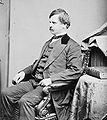
|
| (LOC) |
On the Union side, a command shakeup
resulted from the embarrassing defeat by a smaller force. McDowell's corps remained in the defense of Washington, with only one division
(under Brig. Gen. George A. McCall) able to join McClellan on the Peninsula. Lincoln was disillusioned by the command difficulties of controlling multiple forces in this
campaign and created a single new army, the Army of Virginia, under Maj. Gen. John Pope, incorporating the units of Banks,
Frémont, McDowell, and several smaller ones from around Washington and western Virginia. This army was soundly defeated by
Lee and Jackson in the Northern Virginia Campaign and the Second Battle of Bull Run in August.
Jackson's Valley Campaign: Summary and Timeline of the Principal Events
| DATE |
EVENT |
| May 15, 1862. |
Jackson's command returns from McDowell
to Shenandoah Valley. |
| May 18, 1862. |
Skirmish at Woodstock. |
| May 21, 1862. |
Reconnaissance from Front Royal to Browntown.
|
| May 23, 1862. |
Action at Front Royal. |
| |
Skirmish at Buckton Station. |
| May 24, 1862. |
Frémont ordered to move from Franklin, W.
Va., against Jackson. |
| |
McDowell ordered to put 20,000 men in motion
for the Shenandoah, &c. |
| |
Skirmish at Berryville. |
| |
Skirmish at Strasburg. |
| |
Action at Middletown. |
| |
Action at Newtown. |
| |
Skirmish at Linden. |
| May 24-26, 1862. |
Retreat of Banks' command to Williamsport,
Md. |
| May 24-30, 1862. |
Operations about Harper's Ferry. |
| May 25, 1862. |
Engagement at Winchester. |
| May 26, 1862. |
Skirmish near Franklin, W. Va. |
| May 27, 1862. |
Skirmish at Loudoun Heights. |
| May 28, 1862. |
Skirmish at Charlestown. |
| May 29, 1862. |
Skirmish near Wardensville, W. Va. |
| May 30, 1862. |
Action at Front Royal. |
| May 31, 1862. |
Skirmish near Front Royal. |
| |
Jackson's command retires front Winchester.
|
| June 1, 1862. |
Skirmish at Mount Carmel, near Strasburg.
|
| June 2, 1862. |
Skirmishes at Strasburg and Woodstock. |
| June 3, 1862. |
Skirmish at Mount Jackson. |
| |
Skirmish at Tom's Brook |
| June 6, 1862. |
Action near Harrisonburg. |
| June 7, 1862. |
Skirmish near Harrisonburg. |
| June 8, 1862. |
Rearrangement of the Mountain Department
and Department of the Shenandoah. |
| |
Battle of Cross Keys. |
| June 8-9, 1862. |
Engagements at Port Republic. |
| June 9, 1862. |
Shields' division ordered back to
Luray, en route for Fredericksburg.
|
| June 11-12, 1862 |
Frémont's command withdrawn to Mount Jackson.
|
| June 12, 1862 |
Jackson's command encamps near Weyer's Cave. |
| June 13, 1862. |
Skirmish at New Market. |
| June 16, 1862 |
Skirmish near Mount Jackson. |
| June 17, 1862. |
Jackson's command moves toward Richmond. |
(References and related reading listed below.)
Recommended
Reading: Shenandoah 1862: Stonewall Jackson's Valley Campaign, by Peter Cozzens (Civil War America)
(Hardcover). Description: In the spring of 1862, Federal troops under the command of General George B. McClellan launched
what was to be a coordinated, two-pronged attack on Richmond
in the hope of taking the Confederate capital and bringing a quick end to the Civil War. The Confederate high command tasked
Stonewall Jackson with diverting critical Union resources from this drive, a mission Jackson fulfilled by repeatedly defeating
much larger enemy forces. His victories elevated him to near iconic status in both the North and the South and signaled a
long war ahead. One of the most intriguing and storied episodes of the Civil War, the Valley Campaign has heretofore only
been related from the Confederate point of view. Continued below…
With Shenandoah
1862, Peter Cozzens dramatically and conclusively corrects this shortcoming, giving equal attention to both Union and Confederate perspectives.
Based on a multitude of primary sources, Cozzens's groundbreaking work offers new interpretations of the campaign and the
reasons for Jackson's
success. Cozzens also demonstrates instances in which the mythology that has come to shroud the campaign has masked errors
on Jackson's part.
In addition, Shenandoah 1862 provides the first detailed appraisal of Union leadership in the Valley Campaign, with some surprising
conclusions. Moving seamlessly between tactical details and analysis of strategic significance, Cozzens presents the first
balanced, comprehensive account of a campaign that has long been romanticized but never fully understood. Includes 13 illustrations
and 13 maps. About the Author: Peter Cozzens is an independent scholar and Foreign Service officer with the U.S. Department
of State. He is author or editor of nine highly acclaimed Civil War books, including The Darkest Days of the War: The Battles
of Iuka and Corinth (from the University of North
Carolina Press).
Recommended
Reading: Stonewall in the Valley: Thomas J. Stonewall Jackson's Shenandoah
Valley Campaign, Spring 1862.
Description: The Valley Campaign conducted by Maj. Gen. Thomas J. "Stonewall" Jackson has long fascinated those interested
in the American Civil War as well as general students of military history, all of whom still question exactly what Jackson did in the Shenandoah
in 1862 and how he did it. Since Robert G. Tanner answered many questions in the first edition of Stonewall in the Valley
in 1976, he has continued to research the campaign. This edition offers new insights on the most significant moments of Stonewall's
Shenandoah triumph. Continued below…
About the Author:
Robert G. Tanner is a graduate of the Virginia Military Institute. Tanner is a native of Southern California, he now lives
and practices law in Atlanta, Georgia.
He has studied and lectured on the Shenandoah Valley Campaign for more than twenty-five years.
Recommended
Reading: Three Days in the Shenandoah:
Stonewall Jackson at Front Royal and Winchester (Campaigns and Commanders) (Hardcover).
Description: The battles of Front Royal and Winchester
are the stuff of Civil War legend. Stonewall Jackson swept away an isolated Union division under the command of Nathaniel
Banks and made his presence in the northern Shenandoah Valley so frightful
a prospect that it triggered an overreaction from President Lincoln, yielding huge benefits for the Confederacy. Continued
below…
Gary Ecelbarger
has undertaken a comprehensive reassessment of those battles to show their influence on both war strategy and the continuation
of the conflict. Three Days in the Shenandoah answers questions that have perplexed historians for generations. About the
Author: Gary Ecelbarger, an independent scholar, is the author of Black Jack Logan: An Extraordinary Life in Peace and War
and "We Are in for It!": The First Battle of Kernstown, March 23, 1862.
Recommended
Reading: The Shenandoah Valley Campaign of 1862, by Gary W. Gallagher. Description: In eight new essays, contributors to this volume
explore the Shenandoah Valley campaign, best known for its role in establishing Thomas J. "Stonewall" Jackson's reputation
as a Confederate hero. In early 1862, Union troops under George B. McClellan had arrived within range of Richmond and threatened to take the Confederate capital. Robert E. Lee ordered Jackson to march north through the Shenandoah Valley, hoping to tie
down Federal forces that might otherwise reinforce McClellan's troops. The strategy worked, and for two months the Confederates
evaded and harassed their Union pursuers. Jackson's speed
and audacity boosted plummeting Southern morale, and he emerged from the Valley as the Confederacy's greatest military idol. Continued below…
Contributors
address questions of military leadership, strategy and tactics, the campaign's political and social impact, and the ways in
which participants' memories of events differed from what is revealed in the historical sources. In the process, they offer
valuable insights into one of the Confederacy's most famous generals, those who fought with him and against him, the campaign's
larger importance in the context of the war, and the complex relationship between history and memory. Contributors include
Jonathan M. Berkey, Keith S. Bohannon, Peter S. Carmichael, Gary W. Gallagher, A. Cash Koeniger, R. E. L. Krick, Robert K.
Krick, and William J. Miller. About the Author: Gary W. Gallagher is John L. Nau III Professor of History at the University
of Virginia. He is author, most recently, of Lee and His Army in Confederate
History.
Recommended Reading: Stonewall Jackson: The Man, the Soldier, the Legend (Hardcover) (950 pages). Description: A distinguished Civil War historian unravels the complex character of the Confederacy's greatest general. Drawing on
previously untapped manuscript sources, the author refutes such long-standing myths as Stonewall Jackson's obsessive eating
of lemons and gives a three-dimensional account of the profound religious faith frequently caricatured as grim Calvinism.
Though the author capably covers the battles that made Jackson a legend--Sharpsburg, Fredericksburg, etc.--he emphasizes "the life story of an extraordinary man."
The result is a biography that will fascinate even those allergic to military history. Continued below...
The New York
Times Book Review, Stephen W. Sears . . . [T]wo dozen writers have attempted [Stonewall] biographies, and there are any number
of special studies, monographs and essays. Now going straight to the head of the class of Jacksonbiographers, and likely to
remain there, is James I. Robertson Jr. . . . Stonewall Jackson: The Man, the Soldier, the Legend gives
us far and away the sharpest picture we have ever had of this enigmatic figure.
HIGHLY Recommended Viewing! The American Civil War (DVD Megaset)
(2009) (A&E Television Networks-The History Channel) (14 DVDs) (1697 minutes) (28 Hours 17 Minutes
+ extras). Experience for yourself the historical and personal impact of the Civil War in a way that only HISTORY
can present in this moving megaset™, filled with over 28 hours of American Civil War content. This
MEGASET is the most comprehensive American Civil War compilation to date and is the mother of all Civil War documentaries.
A multifaceted look at “The War Between the States,” this definitive collection brings the most legendary Civil
War battles, and the soldiers and leaders who fought them, vividly to life. From Gettysburg and Antietam to Shiloh, and led
by the likes of Sherman, McClellan, Grant, Beauregard, Lee, Davis, and Jackson, delve into the full military and political
contexts of these men, their armies, and the clashes between them. Continued below...
Almost 150 years after Lee’s surrender at Appomattox Court House,
the unexpected secrets and little-known stories from Civil War history are divulged with fascinating detail. Cutting-edge
CGI and accurate dramatizations illustrate archival letters and original diary entries, and the country’s most renowned
historians describe the less familiar incidents that add perspective and depth to the war that divided a nation. If the DVDs
in this Megaset were purchased separately, it could cost hundreds of dollars. This one-of-a-kind compilation belongs on the
shelf of every Civil War buff, and if you know anyone that is interested in the most costliest and bloodiest war in American
history, buy this, they will love it.
THE AMERICAN CIVIL WAR contains the following programs:
* The Most Daring Mission Of The Civil War
* April 1865
* Battlefield
Detectives: The Civil War (3 Episodes): Antietam, Gettysburg, Shiloh
* Secret Missions Of The Civil War
* The Lost Battle
Of The Civil War
* Tales Of The Gun: Guns Of The Civil War
* Eighty Acres Of Hell
* Lincoln
* Investigating History:
Lincoln: Man Or Myth
* Man, Moment, Machine: Lincoln & The Flying, Spying Machine
* Conspiracy?: Lincoln Assassination
*
High Tech Lincoln
* Sherman’s March
* The Hunt For John Wilkes Booth
* Civil War Combat (4 Episodes): The Hornets’
Nest At Shiloh, The Bloody Lane At Antietam, The Wheatfield At Gettysburg, The Tragedy At Cold Harbor
* Civil War Journal
(8 Episodes): John Brown's War, Destiny At Fort Sumter, The Battle of 1st Bull Run, The 54th Massachusetts, West Point Classmates—Civil
War Enemies, Robert E. Lee, Stonewall Jackson, Sherman And The March To The Sea
BONUS FEATURES:
* Full-Length Documentary “Save Our History: Sherman’s Total
War Tactics”
* Behind the Scenes Featurettes for “Sherman’s March” and “Lincoln”
References: National
Park Service; PBS online; Clark, Champ, and the Editors of Time-Life Books, Decoying the Yanks: Jackson's Valley Campaign,
Time-Life Books, 1984, ISBN 0-8094-4724-X; Cozzens, Peter, Shenandoah 1862: Stonewall Jackson's Valley Campaign, University
of North Carolina Press, 2008, ISBN 978-0-8078-3200-4; Eicher, David J., The Longest Night: A Military History of the Civil
War, Simon & Schuster, 2001, ISBN 0-684-84944-5; Esposito, Vincent J., West Point Atlas of American Wars, Frederick A.
Praeger, 1959; Foote, Shelby, The Civil War, A Narrative: Fort Sumter to Perryville, Random House, 1958, ISBN 0-394-49517-9;
Freeman, Douglas S., Lee's Lieutenants: A Study in Command (3 volumes), Scribners, 1946, ISBN 0-684-85979-3; Gallagher, Gary
W., ed., The Shenandoah Valley Campaign of 1862 (Military Campaigns of the Civil War), University of North Carolina Press,
2003, ISBN 0-8078-2786-X; Hattaway, Herman, and Archer Jones, How the North Won: A Military History of the Civil War, University
of Illinois Press, 1983, ISBN 0-252-00918-5; Henderson, G.F.R., Stonewall Jackson and the American Civil War, Longmans, Green
and Co., London, New York, 1898; Kennedy, Frances H., ed., The Civil War Battlefield Guide, 2nd ed., Houghton Mifflin Co.,
1998, ISBN 0-395-74012-6; Krick, Robert K., Conquering the Valley: Stonewall Jackson at Port Republic, William Morrow &
Co., 1996, ISBN 0-688-11282-X; McPherson, James M., Battle Cry of Freedom: The Civil War Era (Oxford History of the United
States), Oxford University Press, 1988, ISBN 0-19-503863-0; Martin, David G., Jackson's Valley Campaign: November 1861 –
June 1862, Combined Books, 1994, ISBN 0-938289-40-3; Robertson, James I., Jr., Stonewall Jackson: The Man, The Soldier, The
Legend, MacMillan Publishing, 1997, ISBN 0-02-864685-1; Salmon, John S., The Official Virginia
Civil War Battlefield Guide, Stackpole Books, 2001, ISBN 0-8117-2868-4.; Library of Congress; Official Records of the Union
and Confederate Armies.
|

